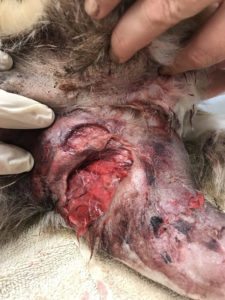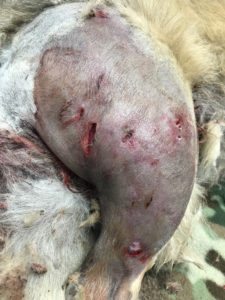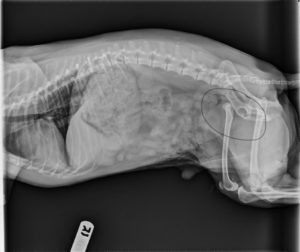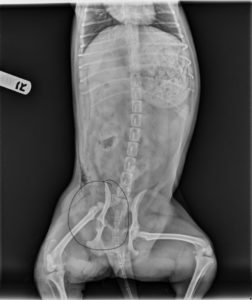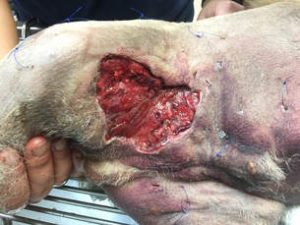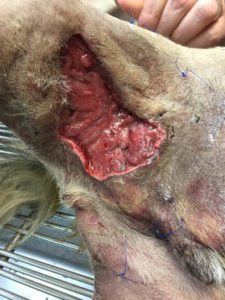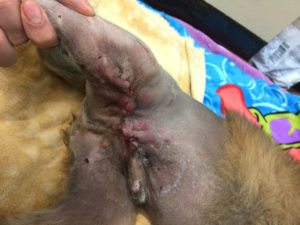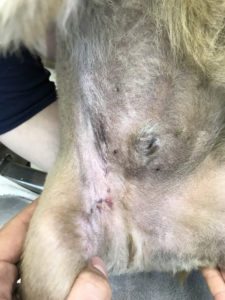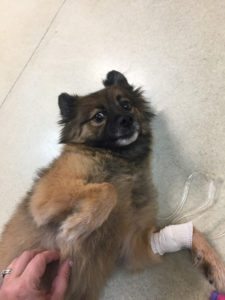The Road to Recovery (A Medical Blog)
[NOTE: The following blog article contains pictures of a semi-graphic medical nature]
Jax was presented as an emergency to Temperance Animal Hospital in August after an altercation with a much larger dog. He had serious injuries which could only be fully assessed following sedation and injectable pain medications had been administered.
Dr. Garcia began by shaving the fur from around the the external wounds before gently cleaning them with sterile flush. Following this initial assessment, it was clear Jax would have a long battle ahead of him. He had a large, deep wound that started on his abdomen near the prepuce of the penis and extended halfway down his thigh. This was a complicated wound with several layers of muscle involved and uncertain damage to surrounding blood supply. In addition to these concerns, bite wounds are inherently dirty/infected wounds and the inner thigh is a “high motion” area which makes bandaging and suturing complicated. Surrounding the larger wound, there were numerous puncture wounds and intense swelling of the entire leg. Here are pictures of how Jax’s wounds looked when he was first assessed by Dr. Garcia.
Medial (inner) aspect of the thigh
Lateral (outer) aspect of the thigh
In addition to these external wounds, Jax had a dislocated right hip that would require surgery to correct.
Before Jax could be considered for surgery, his wounds needed to be debrided (dead or dying tissue removed), blood supply to surrounding areas needed to be confirmed, and his pain needed to be managed. Dr. Garcia started Jax on supportive therapies including: intravenous fluids, continued injectable/patch pain medications, and antibiotics. He consulted with the other veterinarians at TAH to determine the best approach for Jax’s ongoing care.
The medical team decided that Dr. Garcia should continue to manage Jax’s medical and pain control while utilizing Dr. Whitmer’s special expertise for his wound care. Once the extent of the damage could be determined further treatments (including possible amputation) would be determined by Dr. Garcia and Dr. Whitmer.
Dr. Whitmer has a special interest in wound care and utilizes several different techniques to help manage difficult wounds. For Jax, she started by placing loose suture loops in the skin around the wounds (pictured below). This allowed the bandage to be tied into place ensuring that it did not slip since a traditional bandage in this area is problematic. The wound was dressed with raw honey which has excellent healing properties including: gently removing dead tissue, being antibacterial/antifungal, and containing intrinsic growth-like factors which speed healing.
The bandage was changed every day so the wound could be cleaned and dead/loose tissue removed before a fresh bandage was placed. Within three days, the swelling had reduced, blood supply had been confirmed, all dead tissue was removed, and the wound bed was determined to be healthy. Below is a picture of the wound after all dead tissue had been removed.
(3 days into treatment)
Once only healthy tissue remained, it was time to help Jax’s body develop a granulation bed which is a special type of tissue healing that fills in the wound from inside to out. Wounds can be healed fully with granulation tissue (second intention healing) or the edges of the skin can be closed over the healthy granulation tissue (delayed primary closure) to speed healing. Dr. Whitmer used a combination of Silver Sulfadiazine ointment and Insulin to help kick the forming granulation bed into high gear so Jax could have surgery as soon as possible. Just two days later, Jax’s wound was already much smaller and shallower. Dr. Whitmer and Dr. Gracia agreed that Jax would soon be ready for surgery – and he would be able to keep his leg!
(5 days into treatment), Healthy granulation bed and no necrotic tissue remaining.
Dr. Whitmer continued Jax’s wound care for another 3 days until Dr. Garcia performed surgery to repair his dislocated hip and close the wound on the inside of his leg. Dr. Garcia selected a procedure called a Femoral Head and Neck Ostectomy (FHO) to repair Jax’s hip. This is when a portion of the femur (thigh bone) is removed at the level of the hip which allows scar tissue to form around the hip and the dog to walk without the pain of the bone being out of place.
Here is Jax’s wound all closed up!
By the next day, Jax was standing and moving freely. He still has months of physical therapy for his hip ahead of him but is expected to make a complete recovery – a true testament to the power of teamwork and the miraculous ability of the body to heal!
FYI: The owners of both dogs involved in the altercation were very concerned and actively involved in Jax’s recovery.
Two weeks post surgery.
Two weeks post surgery.

